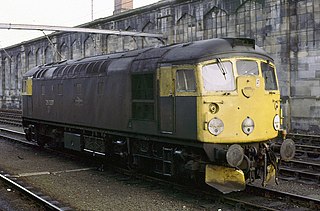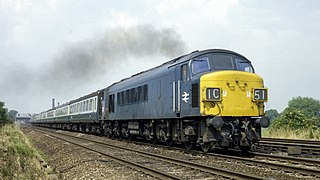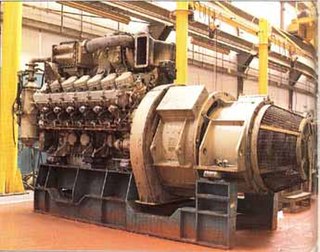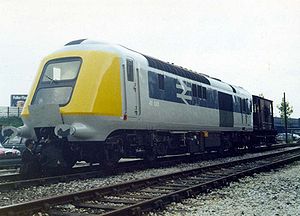
D0280 Falcon was a single prototype diesel-electric locomotive, built for British Railways in 1961. It was one of a series of three prototypes: Falcon, DP2 and Lion, eventually leading to the Class 47 and Class 50. A requirement was expressed by the BTC at a meeting on 15 January 1960 for new Type 4 designs of Co-Co arrangement, which would be lighter than the earlier 1Co-Co1 locomotives such as the Peak classes, produced under the Pilot Scheme.

The British Rail Class 55, also known as a Deltic, or English Electric Type 5, is a class of diesel locomotive built in 1961 and 1962 by English Electric for British Railways. Twenty-two locomotives were built, designed for the high-speed express passenger services on the East Coast Main Line (ECML) between Edinburgh and London King's Cross. They gained the name "Deltic" from the prototype locomotive, DP1 Deltic, which in turn was named after its Napier Deltic power units. At the time of their introduction into service in 1961, the Class 55s were the most powerful single-unit diesel locomotives in the world, with a power output of 3,300 hp (2,500 kW). They had an official maximum speed of 100 miles per hour (160 km/h), and introduced the first regular 100 mph diesel passenger service to Britain, they were however capable of higher speeds than this, and often exceeded their official maximum in service, especially in their later years, with speeds of up to 117 miles per hour (188 km/h), being recorded on level gradients, and up to 125 miles per hour (201 km/h) whilst descending Stoke Bank.

The InterCity 125 (originally Inter-City 125) or High Speed Train (HST) is a diesel-powered high-speed passenger train built by British Rail Engineering Limited between 1975 and 1982. A total of 95 sets were produced, each comprising two Class 43 power cars, one at each end, and a rake of seven or eight Mark 3 coaches. The name is derived from its top operational speed of 125 mph (201 km/h). At times, the sets have been classified as British Rail Classes 253, 254 and 255.

InterCity was introduced by British Rail in 1966 as a brand-name for its long-haul express passenger services.

The British Rail Class 47 or Brush Type 4 is a class of diesel-electric locomotive that was developed in the 1960s by Brush Traction. A total of 512 Class 47s were built at Brush's Falcon Works in Loughborough and at British Railways' Crewe Works between 1962 and 1968, which made them the most numerous class of British mainline diesel locomotive.

The British Rail Class 26 diesel locomotives, also known as the BRCW Type 2, were built by the Birmingham Railway Carriage and Wagon Company (BRCW) at Smethwick in 1958–59. Forty seven examples were built, and the last were withdrawn from service in 1994. Like their higher-powered sisters, the BRCW Classes 27 and 33, they had all-steel bodies and cab ends with fibreglass cab roofs. They were numbered D5300-D5346.

Class 252 was the classification allocated to the prototype High Speed Train (HST) unit, numbered 252001.

The InterCity 225 is an electric high speed train in the United Kingdom, comprising a Class 91 electric locomotive, nine Mark 4 coaches and a Driving Van Trailer (DVT). The Class 91 locomotives were built by British Rail Engineering Limited's Crewe Works as a spin-off from the Advanced Passenger Train project, which was abandoned during the 1980s, whilst the coaches and DVT were constructed by Metro-Cammell in Birmingham and Breda in Italy, again borrowing heavily from the Advanced Passenger Train. The trains were designed to operate at up to 140 mph (225 km/h) in regular service, but are limited to 125 mph (200 km/h) principally due to a lack of cab signalling and the limitations of the current overhead line equipment. They were introduced into service between 1989 and 1991 for intercity services on the East Coast Main Line (ECML) from London King's Cross to Leeds, York and Edinburgh.

The British Rail Mark 3 is a type of passenger carriage developed in response to growing competition from airlines and the car in the 1970s. A variant of the Mark 3 became the rolling stock for the High Speed Train (HST).

DP2, meaning Development Prototype number 2, was a prototype Type 4 mainline diesel locomotive, built by English Electric in 1962. DP2 was effectively the prototype for the later Class 50; it trialled the engine and electronic systems later used in that class of locomotives.

The British Rail Class 43 (HST) is the TOPS classification used for the InterCity 125 High Speed Train (formerly Classes 253 and 254) diesel-electric power cars, built by British Rail Engineering Limited from 1975 to 1982, and in service in the UK since 1976.

The British Rail Class 45 or Sulzer Type 4 are diesel locomotives built by British Railways' Derby and Crewe Works between 1960 and 1962. Along with the similar Class 44 and 46 locomotives, they became known as Peaks.

Old Oak Common TMD was a traction maintenance depot located west of London Paddington, in Old Oak Common. The depot codes were OC for the diesel depot and OO for the carriage shed. In steam days the shed code was 81A.

Neville Hill is a railway train maintenance depot in Osmondthorpe, Leeds, England on the Leeds to Selby Line. The depot is situated 2 miles 14 chains (3.5 km) to the east of Leeds railway station on the north side of the line.

Tinsley Motive Power Depot, latterly Tinsley Traction Maintenance Depot (TMD), was a railway depot in Tinsley, South Yorkshire, near Sheffield. Access by road was from Brinsworth, near Rotherham. The depot was situated on the freight line between Treeton Junction and the A631 Shepcote Lane.

The Paxman Valenta, also known as Y3J and RP200, is a diesel fuelled internal combustion engine formerly made by Paxman in Colchester, England. It was originally developed for, and previously used in the British Rail (BR) Class 43 diesel-electric locomotives, a pair of which powered the InterCity 125 High Speed Train (HST) in a push-pull train set configuration. The Valenta has also been used for electricity generation in diesel generators on offshore oil rig platforms in British waters.

Terence Charles Barry Miller, MBE was an English railway engineer who rose to become Chief Engineer for British Rail.

Holbeck TMD is a traction maintenance depot located in Holbeck, Leeds, England. The depot is located on the west side of the line from Woodlesford, and is 57 chains (1.1 km) south of Leeds railway station.

Locomotive Services Limited is a train operating company in Great Britain. The company operates rail tours using heritage steam, diesel and electric locomotives with support from associated companies and trusts.
The 125 Group is a railway heritage group in England dedicated to the preservation of the InterCity 125s.





















